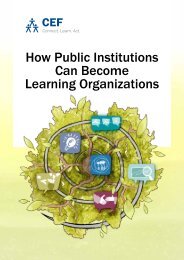TIAPS ALB_Module 2E. Data Analytics for Internal Auditing
- No tags were found...
Create successful ePaper yourself
Turn your PDF publications into a flip-book with our unique Google optimized e-Paper software.
<strong>2E</strong>.4 <strong>Data</strong> Visualization<br />
Auditors gather data from many sources and in different ways. Examples include:<br />
• Interviewing people or conducting focus groups within or outside of the areas being<br />
audited.<br />
• Using questionnaires or checklists to collect in<strong>for</strong>mation, including observations and<br />
opinions from people who work in or deal with the business area being audited.<br />
• Observing the workings within a business area over a period of time to spot issues or<br />
inconsistencies.<br />
• Vertical auditing, in which the auditor monitors one process from beginning to end to<br />
identify any issues.<br />
• Documenting <strong>for</strong>mal practices and procedures within a business area.<br />
• Accessing in<strong>for</strong>mal documentation that may provide insights into ad hoc processes<br />
and procedures. 70<br />
<strong>Data</strong> must be validated by:<br />
• Evaluating whether the data has come from a reliable source and makes sense in<br />
context with the auditors’ overall understanding of the business area.<br />
• Considering how many sources the data are derived from, as well as how long they<br />
took to obtain, to determine if these factors raise risks to data integrity. 71<br />
<strong>Data</strong> visualization can be defined as<br />
the practice of translating in<strong>for</strong>mation into a visual context, such as a map or graph, to<br />
make data easier <strong>for</strong> the human brain to understand and pull insights from. The main<br />
goal of data visualization is to make it easier to identify patterns, trends and outliers in<br />
large data sets. The term is often used interchangeably with others, including in<strong>for</strong>mation<br />
graphics, in<strong>for</strong>mation visualization and statistical graphics. 72<br />
Software makes it easy to create appealing graphics to communicate key in<strong>for</strong>mation<br />
succinctly and powerfully. It can also be a temptation <strong>for</strong> overelaborate and complex pictures<br />
that obscure more than they reveal. Choice of colors, 3-D effects, font size, animation, and<br />
other graphical elements combined with decisions regarding what data to include and to<br />
what level of detail create challenges <strong>for</strong> an auditor completing a report or preparing a<br />
presentation. 73 Auditors should be familiar with the best way to use pie charts, bar charts,<br />
and so on. Some common techniques are described below, based on a Harvard Business<br />
School list. 74<br />
70<br />
<strong>Data</strong> <strong>Analytics</strong> Part 2: Gathering, Understanding, and Visualizing <strong>Data</strong>, The IIA, 2022.<br />
71<br />
<strong>Data</strong> <strong>Analytics</strong> Part 2: Gathering, Understanding, and Visualizing <strong>Data</strong>, The IIA, 2022.<br />
72<br />
<strong>Data</strong> Visualization, TechTarget, Business <strong>Analytics</strong>, 2022.<br />
73<br />
Examples of data visualization tools can be found at The Best <strong>Data</strong> Visualization Tools of 2023, Forbes, 2023.<br />
74<br />
See Harvard Business School online, https://online.hbs.edu/blog/post/data-visualization-techniques<br />
77
















